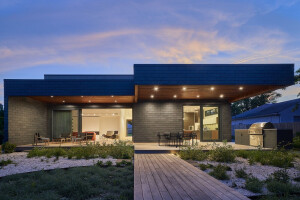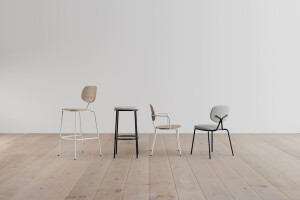The land concerned by this project is located in the center of Toulouse, in the Marengo district, situated between the Matabiau and Colonne neighborhoods. It takes its name from Boulevard de Marengo, which circles around the José-Cabanis Media Library. After the construction of the Matabiau Station, the area, characterized by the construction of low houses (known as "Toulousaines") and some bourgeois residences with gardens, experienced significant development.




The plot is located at 34 Boulevard de la Gare, a street mostly composed of buildings dating from the late 19th and early 20th centuries, built along the canal du Midi. The facades of these buildings have not undergone significant modifications and form a historic ensemble tied to the canal du Midi. To the north of the plot is the Matabiau Station and the Jolimont neighborhood. To the west is the city center of Toulouse. Finally, to the south and east of the plot is the Guilheméry district. The site’s landscape context is remarkable. Along Boulevard de la Gare, it consists of an architectural sequence of buildings dating from the late 19th and early 20th centuries, built along the right bank of the canal du Midi, presenting an architecture that forms a homogeneous ensemble.



The project is based on the concept of "the city on top of the city," adding an elevation to an existing building. The ground floor and the first floor (R+1) will be preserved while maintaining the existing activity. On these floors, only the staircase from R+1 to R+2 are reconfigured to allow circulation leading to R+2. This existing base (ground floor and R+1) occupies the entire plot and did not allow for open ground landscaping. However, a planted strip with planters has been installed along the entire length of the rear facade. The roofs had already been removed, and the existing R+2 level has been demolished to be rebuilt as R+3 with an attic. The former second floor (R+2) was originally a workshop belonging to a local artist and was covered with contemporary graffiti.


The project includes 15 collective housing units consisting of T2 and T3 apartments. A single, continuous elevation is added to the existing building located at the edge of the street on Boulevard de la Gare. An area at the rear of the plot is cleared and designated for outdoor circulation. The project does not include any modifications to the building's access points. There is an access to the parking on the first floor (R+1) located at the northernmost part of the facade. Pedestrian access points are designated for the commercial space in the middle of the facade, and finally, at the southernmost part, there is the building entrance for offices and collective housing.


The ground floor (RDC) is dedicated to the existing commercial space, and the first floor (R+1) to the existing offices. The project focuses on the elevation, which starts from the second floor (R+2) up to the third floor (R+3) and attic for the collective housing units. These are accessed, initially at the ground floor and R+1, by the same interior staircase used for the offices. The staircase leading from R+1 to R+2 has been reconfigured to provide access to an outdoor circulation space at the rooftop terrace level. The staircase to R+3 is aligned with this configuration and similarly serves the other housing units via an exterior walkway. The R+3 apartments are duplexes with attic spaces on the upper floor. All the apartments are now accessed via open-air outdoor circulation, either from the rooftop terrace or the exterior walkway on R+3. Each of the R+2 apartments is accessed by passing through a private terrace before entering the unit. Similarly, the R+3 apartments are accessed via their private terraces. The project integrates harmoniously into the existing urban fabric. On Boulevard de la Gare, the facade follows the regular rhythm of the existing urban sequence through similar openings. On the side facing the railway, the presence of greenery, along with the use of metal and glass, gives the facade a distinctive kinetic character, creating a dialogue between traditional construction and a light contemporary touch in relation to the railway.


On Boulevard de la Gare, the elevation project is characterized by a smooth facade that blends into the existing context with a play of slight recesses, providing a coherent scale to the overall design. The sloped roofs also contribute to this harmonious integration. On the opposite side, facing the railway, "tropéziennes" (rooftop terraces) are placed in the roof to provide terraces for the duplex bedrooms. Skylights are carved out and oriented due east to maximize light for all the housing units. The volume on the railway side is thus more articulated, with the addition of exterior walkways.

Regarding materials, the interior facade (facing the railway) is made up of lightweight metal elements, appropriate for an elevation project on an existing building, emphasizing the contemporary touch on the railway side. Large aluminum windows bring natural light into the apartments. The contrast between the use of metal—such as posts, galvanized steel floor edges, roofing, and aluminum PML cladding on the walls—and the existing plastered base (ground floor and R+1) further highlights the lightness of the elevation compared to the existing structure. A landscaping effort has been made with the installation of numerous planters in both communal and private outdoor spaces. The large terraces are constructed from French-sourced Douglas pine and spruce decking. The wooden structure of the elevation is complemented by a wooden framework and wood-framed walls and floors. The brick facing is locally sourced and handmade. The entire residential complex complies with the new thermal regulations RT 2012 as well as the new acoustic regulations.

The R+1 structure has been reinforced with a metal framework. The wooden roof framework is supported by this new structure starting from R+2. An additional galvanized steel structure has been added to create an exterior walkway that provides access to the apartments. The facade on the boulevard side consists of a wood/wool thermo-acoustic complex finished with red brick cladding. The roof is composed of a traditional wooden framework (trusses made from laminated timber).

Technical Features:
Adress: 34 Boulevard de la Gare, 31000 Toulouse
Client : Eclisse Promotion
Architect: TAA Toulouse | Associated Head of project: Aurélie Guinel | Deputy Head of project: Anne-Claire Chazelat | Project management: Les Economistes Associés | Building inspection office: BTP Consultants
Surface: 1797m2 (including 998m2 of elevation)
Cost: 2.3M€
Delivery date : April 2024













































